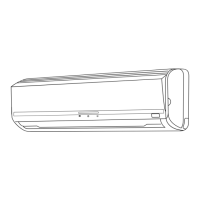
Do you have a question about the Hitachi RAS-12-HNP and is the answer not in the manual?
| Type | Split System |
|---|---|
| Cooling Capacity | 12000 BTU/h |
| Outdoor Unit Noise Level | 50 dB(A) |
| Indoor Unit Weight | 8.5 kg |
| Outdoor Unit Weight | 32 kg |
Basic notes, introduction, and environmental aspects of the UTOPIA series.
Safety precautions, symbols, and regulatory compliance for system design and installation.
Classification and guide for outdoor and indoor unit models.
Critical safety guidelines for unit installation, covering DANGER and CAUTION points.
Safe procedures for transporting outdoor units, including hanging methods and gross weight.
Specifies required installation clearances and basic dimensions for outdoor units.
Guidelines for selecting and preparing installation locations, including foundations and drainage.
Covers the installation of optional accessories like air flow guides, wind guards, and snow protection hoods.
General guidelines and materials for refrigerant piping installation.
Detailed instructions for connecting refrigerant piping to outdoor units.
Specifies permissible piping lengths, system configurations, and combinations.
Procedures and cautions for charging refrigerant, including quantity calculation.
Safety measures and concentration limits related to refrigerant leakage.
Guidelines for using existing piping with new units, including cleaning and renewal kits.
Essential safety precautions and general checks for electrical wiring.
Step-by-step guide for connecting electrical wiring to outdoor units.
Explains DIP switch functions and settings for various operational modes.
Covers wiring between indoor and outdoor units, including wire size recommendations.
Details the features and specifications of the H-LINK II wiring system.
Provides detailed wiring diagrams for various outdoor unit models and power supplies.
Explains control subjects, purpose, and functions for cooling, heating, and defrost operations.
Identifies connectors, switches, and LEDs on the outdoor unit PCBs for various models.
Details compressor protection devices and safety control settings for outdoor units.
Outlines the operational sequences for cooling, dry, heating, and defrost modes.
Explains standard control functions like freezing protection and high-pressure prevention.
Describes available ports and signals for configuring optional functions via the 7-segment display.
Details the setting and description of optional functions controllable via the 7-segment display.
Lists optional functions configurable through the remote control switch (PC-ART).
Essential checks before initiating the test run, including electrical and refrigerant connections.
Step-by-step guide for performing a test run using the PC-ART remote control.
Instructions for conducting a test run using the PC-ARF remote control.
Procedure for performing a test run using the wireless remote control.
Steps for initiating a test run directly from the outdoor unit's DIP switches.
Comprehensive checklist for verifying test run and compressor operations.
Basic checks for common issues using the 7-segment display, power supply, and transmission.
Detailed procedures for diagnosing and resolving issues based on alarm codes and abnormal operations.
Guidance on using the remote control and 7-segment display for diagnosing system faults.
Procedures for checking critical components like inverters, capacitors, and fan motors.
Lists cycle and structural parts for RAS-(2-2.5)HVNP models.
Lists cycle and structural parts for RAS-3HVNC models.
Lists cycle, structural, and electrical parts for RAS-3HVNPE models.
Lists cycle, structural, and electrical parts for RAS-(4-6)H(V)NPE models.
Lists cycle, structural, and electrical parts for RAS-(4-6)H(V)NCE models.
Lists cycle, structural, electrical parts, and parts names for RAS-(8-10)HN(P/C)E models.
Lists cycle, structural, electrical parts, and parts names for RAS-12HN(P/C) models.
General introduction to servicing procedures, including safety warnings.
Detailed procedures for servicing outdoor units of specific models.
Servicing procedures for premium series outdoor units, categorized by model.
Servicing procedures for standard series outdoor units, categorized by model.
Details inverter specifications, time charts, protective functions, and overload control.
Explains the function and characteristics of thermistors used in outdoor units.
Describes the electronic expansion valve's operation and specifications.
Explains the function and activation conditions of high-pressure protection devices.
Details the specifications and circuit diagrams for noise filters.
Provides specifications for capacitors used in the inverter circuit.
Lists specifications and circuit diagrams for reactors used in the inverter.
Explains the reliable mechanism and principle of compression for scroll compressors.
General guidelines for maintenance, including power source checks, compressor issues, and sound.
Routine maintenance tasks for indoor and outdoor units, covering fans, heat exchangers, and electrical equipment.
Provides a template for recording service and maintenance activities.
Explains how to use the 7-segment display for service and maintenance records.
Details how to use the remote control switch for service and maintenance records.
Step-by-step procedure for the pump-down method required for compressor replacement.












